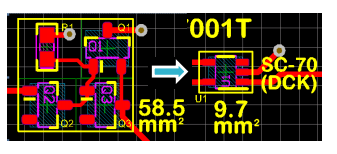SSZT521 march 2019 2N7001T , LM66100 , TPS22919
Most homeowners and apartment dwellers can relate to being woken up in the middle of the night by a chirping smoke detector that needs a new battery. Usually, the smoke detector is installed in a hard-to-access location, so silencing the alarm involves engaging in acrobatics with a broomstick or some other similar object.
Why do smoke detector batteries seem to drain so quickly, especially for a device that is asleep most of the time? The vast majority of smoke detectors are designed to be relatively compact and cost-effective, with a singular purpose of detecting smoke and heat in proximity. Smoke detector designs implement an array of sensors connected to a processor; that processor uses a small battery as its power source to trigger audible and visible indicators. Smoke detector designs need to be kept relatively simple in order to keep costs down and make them easy to install.
One way to keep things simple is to outfit smoke detectors to accept readily available battery types such as 9-V alkaline and lithium batteries. These batteries are inexpensive to replace, but they are not designed to last very long. In order to stretch battery lifetimes as long as possible, smoke detector designs try to implement internal circuits that balance both cost and low current leakage.
One common approach engineers take to lower implementation costs is to use discrete components such as field-effect transistors (FETs), resistors and capacitors in their circuit implementations. The trade-off of discrete components has always been higher current leakage and increased board space usage. Now, however, new ultra-low-power building-block circuits are enabling design engineers to implement very-low-power designs with cost-effective solutions housed in the latest small-footprint packaging technologies.
One example of a device that can replace discrete components without having to compromise the design is the 2N7001T, TI’s newest 1-bit unidirectional voltage-level translator. Voltage translators are essential when interconnecting devices like sensors to the low-power processors used in smoke detector designs, as seen in Figure 1. The 2N7001T enables designers to improve battery life compared to discrete level-translation solutions by dramatically reducing the current leakage associated with low-cost discrete FET and resistor components.
 Figure 1 Residential Smoke and Heat
Detector Design Block Diagram
Figure 1 Residential Smoke and Heat
Detector Design Block DiagramThe 2N7001T consumes and maximum of 8 µA in partial power-down mode and 16 µA during operation. The Ioff protection circuitry of the 2N7001T ensures that no excessive current is drawn from or to an input, output or combined input/output, which is biased to a specific voltage while the device is powered down.
In comparison, common discrete level-translation implementations consist of multiple components where each component contributes to the leakage of the circuit, as shown in Figure 2. Discrete circuits such as these can consume multiple milliamps as a result of current leakage.
 Figure 2 Discrete Push-pull
Level-translation Implementation
Figure 2 Discrete Push-pull
Level-translation ImplementationDepending on the components selected, the leakage can be even higher for discrete implementations. Given the always-on nature of discrete implementations, they can greatly reduce the battery life of the applications in which they’re used.
The other consideration for using an integrated solution like the 2N7001T is implementation size. Since the 2N7001T is a single-component solution housed in a small package, it’s possible to implement the level-translation function using a minimum amount of board space. Comparatively, the discrete level-translation implementation shown in Figure 2 requires four components and a much larger amount of board space to the implement the circuit.
Figure 3 compares the size of the discrete implementation to the 2N7001T implementation.
 Figure 3 Size Comparison between
Discrete Push-pull Level Translation (Left) and the 2N7001T
Implementation
Figure 3 Size Comparison between
Discrete Push-pull Level Translation (Left) and the 2N7001T
ImplementationAnother common ultra-low-power building-block device to consider is a power switch. TI’s newest load switch, the TPS22919, helps maximize a smoke detector’s battery life by reducing the shutdown current in an OFF state. For application uses cases, where key devices do not need to be always active, such as alarm circuitry or sensors, the battery leakage current can be reduced to a maximum of 20 nA by using a load switch solution. Another advantage of using a load switch, instead of a discrete solution, is the reduced number of components as well as a reduction in design complexity. Figure 4 below shows a 76% reduction in solution size with the load switch solution when compared to a comparable discrete FET based solution.
 Figure 4 Load Switch vs Discrete
FET-based Solution Size Comparison
Figure 4 Load Switch vs Discrete
FET-based Solution Size ComparisonAnother potential source of power savings in a smoke detector design can be found in the Power ORing implementation. Power ORing between the main power supply and a backup battery is commonly done with discrete diodes in smoke detectors, as seen previously in Figure 1. These discrete diodes can be replaced with an ideal diode like the LM66100, leading to a significant reduction in power dissipation. Figure 5 below highlights the LM66100 power dissipation savings at various load currents as compared to the discrete solutions. Both the TPS22919 load switch and the LM66100 ideal diode are available in small package options further simplifying your design and extending the battery life of your smoke detector.
 Figure 5 Power Dissipation LM66100 vs
Discrete Implementation
Figure 5 Power Dissipation LM66100 vs
Discrete ImplementationWith the benefit of lower power operation and reduced board-space usage, devices such as the 2N7001T, TPS22919 and LM66100 can enable longer battery life and smaller form factors while keeping costs contained for applications like smoke detectors.
Additional Resources:
- Read the application note, “Common Risks of Discrete FET Voltage Translation and Advantages of TI’s Integrated 2N7001T Level Shifter.”
- Read the LM66100 tech note, “Eliminate the Voltage Drop and Save Power: An Ideal Diode”
- Watch the following videos on our training portal: